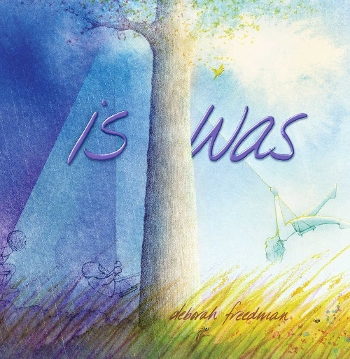Deborah Freedman’s Is Was showcases a patch of land over the course of one day and invites readers to note changes — minute and grand-scale, immediate and more abstract — from the moment a songbird announces daybreak to the moment the sun fades at day’s end.
 Deborah Freedman’s Is Was showcases a patch of land over the course of one day and invites readers to note changes — minute and grand-scale, immediate and more abstract — from the moment a songbird announces daybreak to the moment the sun fades at day’s end. Freedman calls attention to where we are, both in the book’s liminal space and in our more literal position as readers holding a book, and to the fact that we bring ourselves into both of those spaces, which have undoubtedly been seen and touched by an endless rotation of moments that came before.
Deborah Freedman’s Is Was showcases a patch of land over the course of one day and invites readers to note changes — minute and grand-scale, immediate and more abstract — from the moment a songbird announces daybreak to the moment the sun fades at day’s end. Freedman calls attention to where we are, both in the book’s liminal space and in our more literal position as readers holding a book, and to the fact that we bring ourselves into both of those spaces, which have undoubtedly been seen and touched by an endless rotation of moments that came before.
Through expanses of quiet and bits of tension, readers familiarize themselves with recurring characters — a yellow warbler, a chipmunk, a bumblebee, a fox, a child — and acclimate to each of their trajectories. We feel the unbridled joy of the warbler as it rollicks in a puddle, post-downpour. Our hearts thump alongside the chipmunk as it scurries to (narrowly) escape a hawk. The whole book seems a nod to that pestering question about a certain tree falling in a certain forest: in Is Was, the sound is undeniable. Readers are called to hear the metaphorical tree as its trunk cracks, bends, slides through the air, and hits the ground, and the presence of these tangible changes, and of our witnessing them, adds to the book’s power.
In terms of medium, Freedman’s tried and true watercolors with pencil illuminate the tension between permanence and impermanence, with pencil lines firmly holding their ground against a backdrop of ever-changing sky, which starts blue then bleeds gray before clearing again and, ultimately, exploding in crimson. While the jacket proper serves as a vessel containing the day’s full expanse, the boards underneath are a magical moment of serenity; we can still spot, if we look closely, the chipmunk and spider web, but everything else is blanketed in the indigo light of nightfall and resting under a sky full of stars. As we open the book, the bright blue endpapers orient us toward morning, and we’re ready for the warbler as it soars across a musical staff in the morning light of the title page.
The full bleeds are fully immersive. Even the watercolor clouds in the book’s frontmatter are a lesson in impermanence, as they travel over the second half of the title page spread and effect change before the book’s text even begins. And of the text: it’s spare, and placement on the page is key. An "is" personifies to become an aggressive stream of rain; "was" reflects in the ensuing puddle to remind us where it originated. A variation — "WUZZ IZZZ WUZZ" — follows in the wake of a bumblebee traversing a patch of sunflowers. Ellipses abound, pulling us through page-turns, and periods after single words on double-page spreads require us to pause and breathe.
Although so much of Is Was is ephemeral, there are expansive moments of quiet that ask readers to stop and question small details that suggest something much larger. We see the moon only once as the book draws to a close, but its dappled light almost gives the impression that we’re looking at planet Earth — a powerful image as two figures curl up together and gaze upward. A few pages prior, the text itself asks us to “listen ... the Earth’s heart beats ...." Evocative illustrations and a sparely written narrative allow readers, especially young ones, the opportunity to connect with small, ubiquitous details of everyday life while leaving space to float into questions that have no simple answers. “Blue is. Blue was.” This feels like two unfinished sentences.
Freedman’s Is Was works to break through the haze and minutiae of everyday life and is a welcome reminder that we are here together, despite what was, and that tomorrow a songbird, somewhere, will announce daybreak, and the world will pulse with life and the inescapable rhythm that we are all a part of.
[Read the Horn Book Magazine review of Is Was here.]

ALREADY A SUBSCRIBER? LOG IN
We are currently offering this content for free. Sign up now to activate your personal profile, where you can save articles for future viewing.








Add Comment :-
Be the first reader to comment.
Comment Policy:
Comment should not be empty !!!